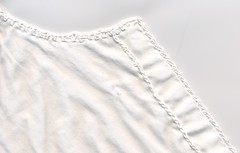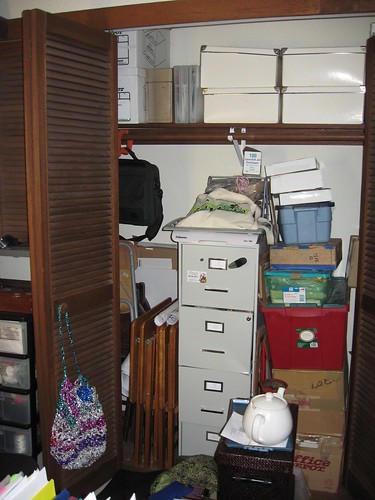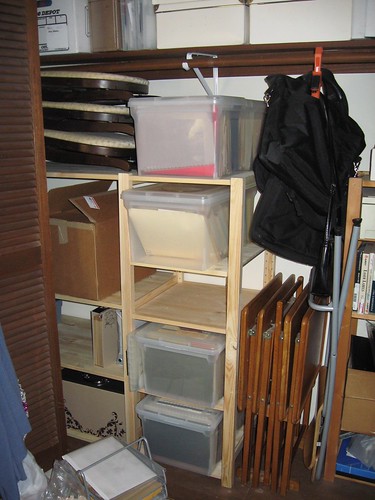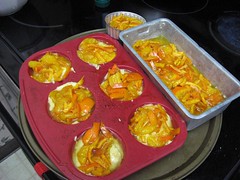Thanks to Kimberly Swygert’s stained white denim jacket, i spent the weekend researching low-water immersion dyeing with a few excursions into how a simple resist might work.
The start was finding that Dharma Trading Company has clothing blanks — undyed clothing ready to take the lovely dyes. But better than than: much of the cotton clothing is assembled in the USA and the company makes an effort to avoid sweatshop conditions in their Indonesian sources for rayon clothing. They’re venturing to bamboo fabrics (essentially a type of rayon) as well. I found myself imagining extreme projects of wardrobes from bolts of undyed organic hemp and sweaters from the undyed yarns offered. I’ve reined myself in to three pairs of socks, a bunch of bandanas, and a tank top. And two skeins of sport- weight yarn.
Tray dying is a type of low-water immersion dying, where just the bunching of the fabric in the tray creates resists. This shows stitching as a resist — and i realize that the sewing machine could help these more delicate cousins to the ever-present tie-dye scale. I understand batik from the time spent making pysansky. And time is the issue there, oh the effort of melting wax. One fiber artist, Paula Burch, points to electric frying pans and appropriate mixtures of beeswax and paraffin, and then there’s boiling the fabric to release the wax — no thanks. But a little note at the bottom about glue resists triggered my imagination.
I found a workshop description noting that ,”[t]echniques include: oatmeal resist, flour resist, cornstarch resist and household glue resist,” but no photos. A silk painting fiber artist described a bit of using glue but a struggle to get it out. Yet, she was doing oh so gently handled and painted silk. The low-water immersion method with procion dyes requires several rinsing steps (low water is relative). That might mean that the resist would need to be reapplied every time — which actually could be quite fascinating in that dyes could go down on bits of fabric that had previously had resist, producing areas with multiple true dye colors.
The diamond+squiggles pattern is a rough experiment in how the transparent procion dyes might layer in an overdying situation. I have resisted beginning a stencil template laser cut from Pokono (but i spent time looking through my collection of global clip art books, and oh, the Japanese seal designs appealed to me). First, actual experimentation would be needed to see how well resists work to see how fine a line could be kept (without going to harder resists like gutta and wax).
The colors in the diagram are grabs from the digital swatches at Dharma. The transparency is just a guess, and my mouse drawn lines are made with less control than i could with an actual brush or applicator. I left some errors, though, just so i could see the effect. The colors don’t show the potential effects from mottled scrunched fabric. My original vision of subtly varigated solids gives way to explosions of pattern and color.
As a final note, i’m not starting with the warm and cool primaries as often outlined in hand dying tutorials. I get my color blending fix from Golden paints, so spend some time looking at the colors predicted as being in next fall and winter and then realized what i really ought to do is look at the beads i’ve bought but haven’t used. Generally, i find myself thinking, “What will i wear with them?” The emerald and sapphire seem to come close to the green and blue glass beads at hand, and i think the copper cording and wire would work well too.
I haven’t placed my order yet. I stay my hand, thinking about WHEN i could do this, recognizing that i’m not sure when i’ll have time to do this. On the other hand — i’ve spent all weekend thinking about it!
Fiber Reactive Dye 2 Oz. – 30A NEW EMERALD GREEN #PR30A-2 30A StockInfo: 1 $4.50 $4.50
Fiber Reactive Dye 2 Oz. – 34 RUST BROWN #PR34-2 34 StockInfo: 1 $3.95 $3.95
Fiber Reactive Dye 2 Oz. – 56 AZURE BLUE #PR56-2 56 StockInfo: 1 $6.95 $6.95
Fiber Reactive Dye 2 Oz. – 64 ORCHID #PR64-2 64 StockInfo: 1 $3.95 $3.95













